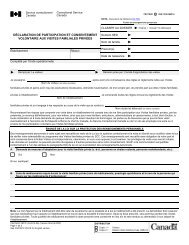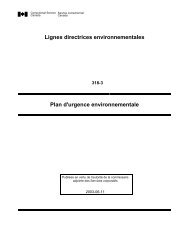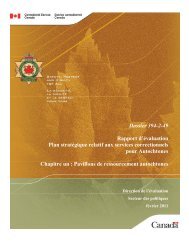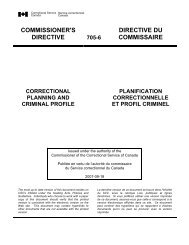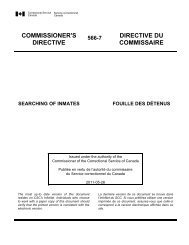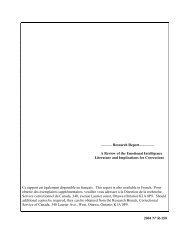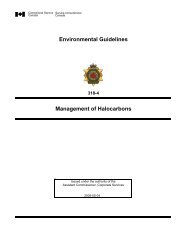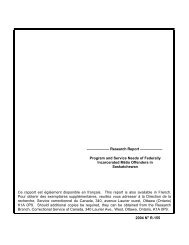The Brief Symptom Inventory (BSI) - Service correctionnel du Canada
The Brief Symptom Inventory (BSI) - Service correctionnel du Canada
The Brief Symptom Inventory (BSI) - Service correctionnel du Canada
Create successful ePaper yourself
Turn your PDF publications into a flip-book with our unique Google optimized e-Paper software.
antisocial personality disorder, 89% had a co-morbid substance dependence or abuse<br />
problem.<br />
Determining a formal substance abuse diagnosis was not possible <strong>du</strong>ring the<br />
CoMHISS pilot but the CASA supplies very detailed information on the extent of offenders’<br />
drug and alcohol use and the level of dependence. Peters, Greenbaum, Steinberg, Carter,<br />
Ortiz, Fry, & Valle (2000) have shown that results from the ADS (a component test of the<br />
CASA that measures alcohol dependence) are closely related to DSM IV diagnoses of<br />
substance abuse problems. In this current study, co-occurrence of a substance abuse disorder<br />
and a mental health concern was analysed by assessing the percentage of CoMHISS<br />
respondents who had either GSI or DHS T-scores at or over 65 and had scores on the ADS,<br />
DAST and PRD at levels suggesting substantial to severe levels of abuse. A second analysis<br />
determined rates of co-morbidity using a more liberal formula that set the criterion for a<br />
substance abuse disorder as ratings of at least moderate (on the ADS and DAST) or “some<br />
problems” on the PRD.<br />
Table 17 presents the results by indivi<strong>du</strong>al substance abuse measures and an overall<br />
analysis in which a substance abuse problem as assessed by any of the three substance abuse<br />
measures was taken as an indication of a substance abuse disorder. A stringent estimate of<br />
the rate of substance abuse disorders and a T-score at or above 65 on the CoMHISS Global<br />
Severity Index pro<strong>du</strong>ces an estimate of co-occurring disorders of about 53% while the rate<br />
increases to 69% using a more liberal cut off for a substance abuse disorder. <strong>The</strong> rate of<br />
substance abuse problems for offenders screened in as having a mental health problem based<br />
on the CoMHISS is significantly higher than for those offenders who were not screened in<br />
using either the conservative (χ 2 (1) = 63.28, p < .001) or liberal criterion for a diagnosis of<br />
substance abuse (χ 2 (1) = 35.77, p < .001). When the data are analysed looking only at<br />
offenders with serious substance abuse problems we again see a strong link between<br />
substance abuse and mental health problems. Seventy-eight percent of offenders who have a<br />
substantial to severe dependence on alcohol report having mental health symptoms, while the<br />
rates are somewhat lower for those with serious drug problems at 58%. <strong>The</strong>se results are<br />
preliminary but they do indicate that those with higher levels of psychological distress are<br />
more likely to have substance abuse problems. Further research is required that would<br />
34



